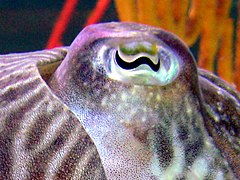
Pupil
The pupil is a hole located in the center of the iris of the eye that allows light to strike the retina.[1] It appears black because light rays entering the pupil are either absorbed by the tissues inside the eye directly, or absorbed after diffuse reflections within the eye that mostly miss exiting the narrow pupil. The size of the pupil is controlled by the iris, and varies depending on many factors, the most significant being the amount of light in the environment. The term "pupil" was coined by Gerard of Cremona.[2]
For other uses, see Pupil (disambiguation).Pupil
In humans, the pupil is circular, but its shape varies between species; some cats, reptiles, and foxes have vertical slit pupils, goats and sheep have horizontally oriented pupils, and some catfish have annular types.[3] In optical terms, the anatomical pupil is the eye's aperture and the iris is the aperture stop. The image of the pupil as seen from outside the eye is the entrance pupil, which does not exactly correspond to the location and size of the physical pupil because it is magnified by the cornea. On the inner edge lies a prominent structure, the collarette, marking the junction of the embryonic pupillary membrane covering the embryonic pupil.
Society and culture
The pupil plays a role in eye contact and nonverbal communication. The voluntary or involuntary enlargement or dilation of the pupils indicates cognitive arousal, interest in the subject of attention, and/or sexual arousal. On the other hand, when the pupil is voluntarily or involuntarily contracted, it could indicate the opposite - disinterest or disgust. Exceptionally large or dilated pupils are also perceived to be an attractive feature in body language.[23]
In a surprising number of unrelated languages, the etymological meaning of the term for pupil is "little person".[24][25] This is true, for example, of the word pupil itself: this comes into English from Latin pūpilla, which means "doll, girl", and is a diminutive form of pupa, "girl". (The double meaning in Latin is preserved in English, where pupil means both "schoolchild" and "dark central portion of the eye within the iris".)[26] This may be because the reflection of one's image in the pupil is a minuscule version of one's self.[24] In the Old Babylonian period (c. 1800-1600 BC) in ancient Mesopotamia, the expression "protective spirit of the eye" is attested, perhaps arising from the same phenomenon.
The English phrase apple of my eye arises from an Old English usage, in which the word apple meant not only the fruit but also the pupil or eyeball.[27]





